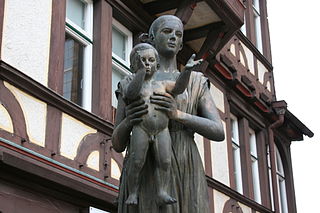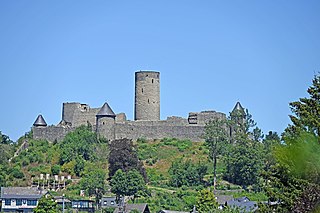Related Research Articles

Albert the Bear was the first margrave of Brandenburg from 1157 to his death and was briefly duke of Saxony between 1138 and 1142.

Henry I of Hesse "the Child" was the first Landgrave of Hesse. He was the son of Henry II, Duke of Brabant and Sophie of Thuringia.

Dietrich or Theoderic of Oldenburg was a feudal lord in Northern Germany, holding the counties of Delmenhorst and Oldenburg. He was called "Fortunatus", as he was able to secure Delmenhorst for his branch of the Oldenburgs.

Nürburg is a town in the German district of Ahrweiler, in the state of Rhineland-Palatinate. It is also the name of the local castle, Nürburg Castle, which was built in the High Middle Ages. The castle is made of basalt which usually has black color. The well-known 24-kilometre (15 mi) racing track Nürburgring is nearby.
Adolf of Altena, Adolf of Berg or Adolf of Cologne, was Archbishop of Cologne from 1193 to 1205.
Theodoric I, called the Oppressed, was the Margrave of Meissen from 1198 until his death. He was the second son of Otto II, Margrave of Meissen and Hedwig of Brandenburg.

Gerhard VI, Count of Oldenburg was a Count of Oldenburg and regent of Bad Zwischenahn in 1440–1482.
Dietrichof Haldensleben was a count in the Schwabengau, later also in the Nordthüringgau and the Derlingau, who was the first Margrave of the Northern March from 965 until the Great Slav Rising of 983. He also bore the title of a dux (duke) in contemporary sources.He was a ancestor of John V

Bernard II was Lord of Lippe from 1167 until 1196. He founded the towns of Lippstadt and Lemgo.
William IV, Count of Jülich was the son and heir of William III of Jülich and Mathilde of Limburg, daughter of Waleran III, Duke of Limburg.
Adolf VII of Berg was the eldest son of Henry IV, Duke of Limburg and Irmgard of Berg.

The City Hall is a historical building in Cologne, western Germany. It is located off Hohe Straße in the district of Innenstadt, and set between the two squares of Rathausplatz and Alter Markt. It houses part of the city government, including the city council and offices of the Lord Mayor. It is Germany's oldest city hall with a documented history spanning some 900 years. The history of its council during the 11th century is a prominent example for self-gained municipal autonomy of Medieval cities.

Are Castle is the ruin of a hill castle that stands at a height of 240 m above sea level (NHN) above the village of Altenahr in the German state of Rhineland-Palatinate. It was built around 1100 by Count Dietrich I of Are and is first recorded in 1121.
Lothar von Hochstaden was Bishop of Liège and archchancellor.
Countess Mechthild of Sayn, also called Mechthild of Landsberg, Mechtild, Mechtildis or Mathilde, was the wife of Henry III of Sayn. She was an important figure in the Late Middle Ages because of her religious foundations (Stiftungen).
Otto I, Count of Waldeck was the count of Waldeck from 1275/76 until his murder in November 1305.
References
- ↑ Gerhard Taddey: Encyclopedia of German history. 2e., Stuttgart 1983, ISBN 3-520-80002-0, S. 339
- ↑ Julius Ficker: From Imperial Prince. Research into the history of the constitution first in XII. and XIII. Century. Innsbruck 1861, p.92.
- ↑ Konrad Kretschmer: Historical geography of Central Europe. Munich/Berlin 1904 S. 253
- ↑ Donald C. Jackman: Hochstaden: Public Succession in Ripuaria of the High Middle Ages. Archive for Medieval Prosopography 7/2009